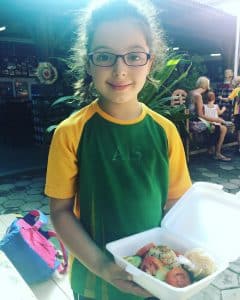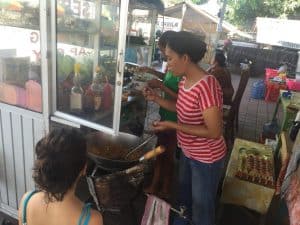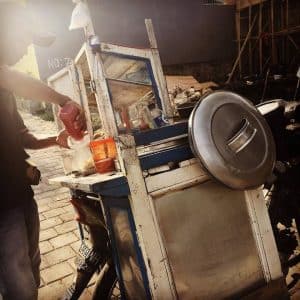




























 Foodie Scene
Foodie Scene
The food in Bali is so diverse! You can enjoy an exquisite meal one night and then eat at your local warung the next. The foodie scene is HUGE and every second person is posting their gorgeous looking meal on Instagram.
Top restaurants are found everywhere with amazing food, décor and views! These stunning restaurants overlook rice paddies, gardens and the beach. For example, we have dined at Metis, Merah Puti, Sarong, Sardine, Mamasan and Barbacoa just to name a few.
The Café culture is strong and it is easy to find great breakfast spots with delicious and interesting menus. The most popular thing on the breakfast menu (which you can get all day) is a fruit smoothie bowl. This is whipped up exotic fruits topped with nuts, granola, coconut flakes, sliced fruit and many other healthy additions.
There is a new café opening up every week (sadly some are closing down too) and everyone is trying to be different. One thing that a cafés are promoting is that they are organic – in fact our favourite breakfast place at the moment is Café Organic in Pettitinget – and of course we love eating the ‘Bondi Bowl’.
Nasi Campur
Nasi Campur is the main staple meal and it is available for breakfast, lunch and dinner.
Nasi Campur is a buffet of food accompanied by rice. This buffet changes everyday but there are some regular items too. So you can make a mixed plate of vegetables, tempe, tofu, fish, chicken and beef. They also cook food like egg frittatas, mie goreng and beef randang. Some of the dishes are spicy and there is always sambal or peanut sauce to add.Depending on where you are in Indonesia the style and type of Nasi Campur will change.Often we will have this for lunch at a local Warung and it will cost no more than $2 a plate.
Hitting the markets
Every Monday I visit the local markets and buy fresh fruit, vegetables and flowers. By shopping this way it has made me appreciate fruit and vegetables. There are about 30 different vendors selling their produce that have come from farm that morning. It is wonderful to see the local vegetables and fruit on offer, some we have never tried before and others that would have been expensive back home. Of course there are some imports that will always be pricey but you can get the local equivalent. As I shop, I wish I could speak the language (just started some lessons!) but often the stall holders can speak a little English and with hand gestures and calculators it works!
My favourite local fruit is the red dragon fruit (Buah Naga) which is beetroot in colour and can stain like a beetroot too! Full of vitamins and a delicious taste it is often found on many menus. Our fridge is full of other fruit like mango, lychee, mangosteen, pawpaw, snake fruit, baby bananas, watermelon and pineapple. The other day I counted 13 different types of fruit at home! It’s been fun making up our own smoothies at home and we get a few fresh coconuts for $1 each.
Trying new foods
The kids are trying to eat some local food but a lot of the time even a local place can offer Western food. So far it is Nasi goreng, Satay chicken and Mie goreng for the kids. At least the kids are happy to try what we eat too!
Expat food
Imported food can get expensive and things like sliced meat, cheeses and cereal are pricey. For example, wheet bix is about $10+ a box, some good honey about $12 a jar and vegemite is about $20! There are the odd things that aren’t even available but I wouldn’t say we are craving anything from back home.
Go Jek
Eating out or getting takeaway is often a lot cheaper than cooking at home. There is so many local Warungs to choose from and for the last year Bali has started a great delivery service called Go Jek (an app on your phone) that will pick up food (and many other services like Go ride, Go Send, Go Massage, Go Clean) from your favourite restaurants and cafes and deliver for about $1.50. You can track on a map when they have picked up your food and how long it will take to get to you.
Around the neighbourhood
Early in the morning, on the way to school we see some little stalls on the pavement that set up outside closed shops selling traditional cakes/biscuits (10c each) and some Nasi Campur. It has been great to drop by for a treat or when you have people over for morning tea! You can also see motorbikes stopped on the side of the road selling little Nasi Campur packets for about the equivalent of 50c – $1. They are extremely popular with the locals and it is a great way to have breakfast on the run!
In the afternoons, there are men walking up and down the streets with their Bakso cart. It is a make shift tiny food shop selling soup with fish or pork balls. It is a popular snack for locals and to let you know he is in the area he taps a silver spoon on one of his bowls – it’s the Bakso bell! A twist on the Mr Whippy days!
In our local village (about a 8 min walk from our house) there is a great health food shop/café called Bali Buda, French bakery, a great British pub and a delicious Japanese restaurant. On Friday or Saturday nights Liam and Trent sometimes hang out at another local pub runs by Australians from Perth and they watch the AFL on TV.
Next door to our house is a rice field and we have watched over the last few months rice being carefully planted and then harvested by a husband and wife team who are about 70 yrs old. It is hard work and the process goes for many months which gives them enough rice to feed their large family for about 6 months. They don’t speak any English but we wave and smile and say a few Bahasa words to them.
Seeing so many rice fields here and the hard labour involved you have a new appreciation for rice. Sometimes we use the rice cooker at home and when we do it creates a lovely aroma in the house, especially when you add lemongrass and curry leaves or coconut milk. Demi also learnt how to make Nasi Goreng in her school cooking class so it has been fun making our own Nasi Goreng at home.


































